Clay Mineral Characteristics and Smectite-to-Illite Transformation in the Chang-7 Shale, Ordos Basin: Processes and Controlling Factors
Abstract
1. Introduction
2. Geological Settings
3. Materials and Methods
3.1. Materials
3.2. X-Ray Diffraction (XRD) Analysis
3.3. Organic Geochemical Analyses
4. Results
4.1. Clay Mineral Composition and Basin-Wide Distribution
4.2. Mineralogical Characteristics and Total Organic Carbon Content of Well YY1
4.3. Characteristics of Illite-Smectite Mixed-Layer Minerals and Organic Matter Evolution
5. Discussion
5.1. Controls of Surficial Geological Processes on Clay Mineral Spatial Distribution
5.2. The Correlation Between Clay Mineral Abundance and Other Mineral Constituents
5.3. Impact of Organic Matter on Clay Mineral Composition and Diagenetic Evolution
6. Conclusions
- (1)
- Frequent volcanic activity during the depositional period of the Chang-7 Member supplied abundant source materials for smectite formation, resulting in the predominance of I/S in the majority of samples. Provenance characteristics and sedimentary systems jointly govern the differentiated planar distribution patterns of clay minerals, serving as principal controls for kaolinite and chlorite distribution, respectively.
- (2)
- Inter-mineral water-rock interactions exert significant controls on clay mineral evolution. The transformation processes necessitate the dissolution of K-feldspar and plagioclase (with K-feldspar being preferentially consumed), resulting in a pronounced negative correlation between clay mineral content and K-feldspar abundance. Although quartz and carbonate minerals can precipitate as authigenic phases, such diagenetic modifications remain insignificant in the Chang-7 shale.
- (3)
- Organic matter acts as a critical component in the organic-rich Chang-7 shale, driving co-evolution with clay minerals during progressive burial and thermal maturation. The accelerated illitization of smectite and the negative correlation between mixed-layer ratios and TOC content demonstrate that organic matter plays a dominant role in mineral transformation, primarily through decarboxylation, hydrocarbon cracking during thermal maturation, and enhanced dissolution of potassium feldspar.
Supplementary Materials
Author Contributions
Funding
Data Availability Statement
Conflicts of Interest
References
- Meunier, A. Clays; Springer Science & Business Media: Berlin, Germany, 2005; ISBN 3-540-21667-7. [Google Scholar]
- Jiang, S. Clay Minerals from the Perspective of Oil and Gas Exploration. In Clay Minerals in Nature—Their Characterization, Modification and Application; InTech: London, UK, 2012; pp. 21–38. ISBN 978-953-51-0738-5. [Google Scholar]
- Dilli, K.; Pant, R.K. Clay Minerals as Indicators of the Provenance and Palaeoclimatic Record of the Kashmir Loess. J. Geol. Soc. India 1994, 44, 563–574. [Google Scholar] [CrossRef]
- Franke, D.; Ehrmann, W. Neogene Clay Mineral Assemblages in the AND-2A Drill Core (McMurdo Sound, Antarctica) and Their Implications for Environmental Change. Palaeogeogr. Palaeoclimatol. Palaeoecol. 2010, 286, 55–65. [Google Scholar] [CrossRef]
- Ola, P.S.; Aidi, A.K.; Bankole, O.M. Clay Mineral Diagenesis and Source Rock Assessment in the Bornu Basin, Nigeria: Implications for Thermal Maturity and Source Rock Potential. Mar. Pet. Geol. 2018, 89, 653–664. [Google Scholar] [CrossRef]
- Wu, L.; Zhou, C.; Keeling, J.; Tong, D.; Yu, W. Towards an Understanding of the Role of Clay Minerals in Crude Oil Formation, Migration and Accumulation. Earth-Sci. Rev. 2012, 115, 373–386. [Google Scholar] [CrossRef]
- Pevear, D.R. Illite and Hydrocarbon Exploration. Proc. Natl. Acad. Sci. USA 1999, 96, 3440–3446. [Google Scholar] [CrossRef]
- Bu, H.; Yuan, P.; Liu, H.; Liu, D.; Liu, J.; He, H.; Zhou, J.; Song, H.; Li, Z. Effects of Complexation between Organic Matter (OM) and Clay Mineral on OM Pyrolysis. Geochim. Cosmochim. Acta 2017, 212, 1–15. [Google Scholar] [CrossRef]
- Loucks, R.G.; Reed, R.M.; Ruppel, S.C.; Hammes, U. Spectrum of Pore Types and Networks in Mudrocks and a Descriptive Classification for Matrix-Related Mudrock Pores. AAPG Bull. 2012, 96, 1071–1098. [Google Scholar] [CrossRef]
- Zhang, W.; Zhou, S.; Yu, Z.; Liu, X.; Wang, S.; Miao, H.; Liu, D.; Tian, J.; Wang, H. Controls of Clay Mineral Transformation and Organic Matter on Pore Networks of the Paleogene Lacustrine Shale Oil System in the Yitong Basin, NE China. J. Asian Earth Sci. 2025, 280, 106469. [Google Scholar] [CrossRef]
- Worden, R.H.; Morad, S. (Eds.) Clay Mineral Cements in Sandstones, 1st ed.; Wiley: Hoboken, NJ, USA, 1999; ISBN 978-1-4051-0587-3. [Google Scholar]
- Wilson, M.J.; Wilson, L.; Shaldybin, M.V. Clay Mineralogy and Unconventional Hydrocarbon Shale Reservoirs in the USA. II. Implications of Predominantly Illitic Clays on the Physico-Chemical Properties of Shales. Earth-Sci. Rev. 2016, 158, 1–8. [Google Scholar] [CrossRef]
- Kang, Y.; Liu, K.-Q.; Zhu, R.-K.; Yin, G.-G.; Zhang, J.-Y.; Zhang, S.-R. The Evolution of Clay Mineral and Its Indication of Hydrocarbons under Overpressure: An Example from the Shale of the Qingshankou Formation in the Gulong Sag. Pet. Sci. 2024, 21, 3867–3883. [Google Scholar] [CrossRef]
- De Silva, P.N.K.; Simons, S.J.R.; Stevens, P.; Philip, L.M. A Comparison of North American Shale Plays with Emerging Non-Marine Shale Plays in Australia. Mar. Pet. Geol. 2015, 67, 16–29. [Google Scholar] [CrossRef]
- Deng, H.; Xie, X.; Chen, K.; Vij, C.; Pang, Y.; Li, H.A. Mineralogical Characteristics of Continental Shale: A Case Study in Yan-Chang Formation, Ordos Basin. Aust. J. Earth Sci. 2018, 65, 851–862. [Google Scholar] [CrossRef]
- Pozo, M.; Calvo, J.P. An Overview of Authigenic Magnesian Clays. Minerals 2018, 8, 520. [Google Scholar] [CrossRef]
- Smoot, T.W. Clay Mineralogy of Pre-Pennsylvanian Sandstones and Shales of the Illinois Basin. Part III: Clay Minerals of Various Facies of Some Chester Formations; Circular 293; Illinois State Geological Survey: Champaign, IL, USA, 1960; pp. 1–19. [Google Scholar]
- Keller, W.D. Diagenesis in Clay Minerals—A Review. Clays Clay Miner. Natl. Conf. Clays Clay Miner. 1962, 11, 136–157. [Google Scholar] [CrossRef]
- Liu, W.; Zhu, Q.; Qiao, Y.; Wu, W.; Pan, J.; Mou, C.; Yao, J.; Chen, Y. Origin of Authigenic Quartz in Organic-Rich Shales of the Dalong Formation (NW Middle Yangtze Basin), South China: Implications for Pore Network Development. Energy Fuels 2024, 38, 6912–6926. [Google Scholar] [CrossRef]
- Liang, C.; Wang, J.; Cao, Y.; Xiong, Z.; Liu, K.; Hao, F.; Han, W. Authigenic Calcite in Shales: Implications for Tracing Burial Processes and Diagenetic Fluid Evolution in Sedimentary Basins. Earth-Sci. Rev. 2024, 258, 104935. [Google Scholar] [CrossRef]
- Środoń, J. Nature of Mixed-Layer Clays and Mechanisms of Their Formation and Alteration. Annu. Rev. Earth Planet. Sci. 1999, 27, 19–53. [Google Scholar] [CrossRef]
- Zanoni, G.; Šegvić, B.; Moscariello, A. Clay Mineral Diagenesis in Cretaceous Clastic Reservoirs from West African Passive Margins (the South Gabon Basin) and Its Impact on Regional Geology and Basin Evolution History. Appl. Clay Sci. 2016, 134, 186–209. [Google Scholar] [CrossRef]
- Ahmat, A.M.; Boussafir, M.; Le Milbeau, C.; Guégan, R.; De Oliveira, T.; Le Forestier, L. Organic Matter and Clay Interaction in a Meromictic Lake: Implications for Source Rock OM Preservation (Lac Pavin, Puy-de-Dôme, France). Org. Geochem. 2017, 109, 47–57. [Google Scholar] [CrossRef]
- Gu, Y.; Wan, Q.; Li, X.; Han, T.; Yang, S.; Hu, Q. Structure and Evolution of Clay-Organic Nanocomposites in Three Leading Shales in China. J. Earth Sci. 2023, 34, 824–837. [Google Scholar] [CrossRef]
- Berthonneau, J.; Grauby, O.; Abuhaikal, M.; Pellenq, R.J.-M.; Ulm, F.J.; Van Damme, H. Evolution of Organo-Clay Composites with Respect to Thermal Maturity in Type II Organic-Rich Source Rocks. Geochim. Cosmochim. Acta 2016, 195, 68–83. [Google Scholar] [CrossRef]
- Rahman, H.M.; Kennedy, M.; Löhr, S.; Dewhurst, D.N. Clay-Organic Association as a Control on Hydrocarbon Generation in Shale. Org. Geochem. 2017, 105, 42–55. [Google Scholar] [CrossRef]
- Collins, M.J.; Bishop, A.N.; Farrimond, P. Sorption by Mineral Surfaces: Rebirth of the Classical Condensation Pathway for Kerogen Formation? Geochim. Cosmochim. Acta 1995, 59, 2387–2391. [Google Scholar] [CrossRef]
- Adams, R.S.; Bustin, R.M. The Effects of Surface Area, Grain Size and Mineralogy on Organic Matter Sedimentation and Preservation across the Modern Squamish Delta, British Columbia: The Potential Role of Sediment Surface Area in the Formation of Petroleum Source Rocks. Int. J. Coal Geol. 2001, 46, 93–112. [Google Scholar] [CrossRef]
- Lao, Y.; Korth, J.; Ellis, J.; Crisp, P.T. Heterogeneous Reactions of 1-Pristene Catalysed by Clays under Simulated Geological Conditions. Org. Geochem. 1989, 14, 375–379. [Google Scholar] [CrossRef]
- Jin, Z.; Wang, G.; Liu, G.; Gao, B.; Liu, Q.; Wang, H.; Liang, X.; Wang, R. Research progress and key scientific issues of continental shale oil in China. Acta Pet. Sin. 2021, 42, 821–835. [Google Scholar] [CrossRef]
- Wang, Z.; Dong, L.; Jin, Z.; Zou, S.; Fu, J.; Zhu, R. Efforts to Untie the Multicollinearity Knot and Identify Factors Controlling Macropore Structures in Shale Oil Reservoirs. Adv. Geo-Energy Res. 2024, 11, 194–207. [Google Scholar] [CrossRef]
- Chu, R.; Wu, H.; Zhu, R.; Fang, Q.; Deng, S.; Cui, J.; Yang, T.; Li, H.; Cao, L.; Zhang, S. Orbital Forcing of Triassic Megamonsoon Activity Documented in Lacustrine Sediments from Ordos Basin, China. Palaeogeogr. Palaeoclimatol. Palaeoecol. 2020, 541, 109542. [Google Scholar] [CrossRef]
- Tang, X.; Zhang, J.; Wang, X.; Yu, B.; Ding, W.; Xiong, J.; Yang, Y.; Wang, L.; Yang, C. Shale Characteristics in the Southeastern Ordos Basin, China: Implications for Hydrocarbon Accumulation Conditions and the Potential of Continental Shales. Int. J. Coal Geol. 2014, 128, 32–46. [Google Scholar] [CrossRef]
- Zhang, C.; Zhang, L.; Chen, T.; Zhag, Y.; Yang, Y.; Huang, J.; He, J.; Li, H. Provenance and Parent-Rock Types of Member 7 of Yanchang Formation(Triassic), Ordos Basin. Acta Sedimentol. Sin. 2013, 31, 430–439. [Google Scholar] [CrossRef]
- Zou, C.; Wang, L.; Li, Y.; Tao, S.; Hou, L. Deep-Lacustrine Transformation of Sandy Debrites into Turbidites, Upper Triassic, Central China. Sediment. Geol. 2012, 265, 143–155. [Google Scholar] [CrossRef]
- Chen, P.; Xian, B.; Li, M.; Fang, L.; Rahman, N.U.; Liu, J.; Chen, S.; Tian, R.; Wu, Q. Intensified Lacustrine Turbidite Deposition as a Response to the Carnian Pluvial Episode: Insights from the Triassic Ordos Basin in North China Plate. Palaeogeogr. Palaeoclimatol. Palaeoecol. 2023, 623, 111599. [Google Scholar] [CrossRef]
- Qiu, X.; Liu, C.; Mao, G.; Deng, Y.; Wang, F. Enrichment Feature of Thorium Element in Tuff Interlayers of Upper Triassic Yanchang Formation in Ordos Basin, China. Geol. Bull. China 2010, 29, 1185–1191. [Google Scholar] [CrossRef]
- Deng, S.; Lu, Y.; Luo, Z.; Fan, R.; Li, X.; Zhao, Y.; Ma, X.; Zhu, R.; Cui, J. Subdivision and Age of the Yanchang Formation and the Middle/Upper Triassic Boundary in Ordos Basin, North China. Sci. China Earth Sci. 2018, 61, 1419–1439. [Google Scholar] [CrossRef]
- Fu, J.; Li, S.; Guo, Q.; Guo, W.; Zhou, X.; Liu, J. Enrichment conditions and favorable area optimization of continental shale oil in Ordos Basin. Acta Pet. Sin. 2022, 43, 1702–1716. [Google Scholar] [CrossRef]
- Yang, H.; Zhang, W.; Wu, K.; Li, S.; Peng, P.; Qin, Y. Uranium Enrichment in Lacustrine Oil Source Rocks of the Chang 7 Member of the Yanchang Formation, Erdos Basin, China. J. Asian Earth Sci. 2010, 39, 285–293. [Google Scholar] [CrossRef]
- Wang, C.; Wang, Q.; Chen, G.; He, L.; Xu, Y.; Chen, L.; Chen, D. Petrographic and Geochemical Characteristics of the Lacustrine Black Shales from the Upper Triassic Yanchang Formation of the Ordos Basin, China: Implications for the Organic Matter Accumulation. Mar. Pet. Geol. 2017, 86, 52–65. [Google Scholar] [CrossRef]
- Wang, T.; Yang, B. Source-Rock Burial History of Triassic Yanchang Group Chang 7 Formation in Ordos Basin. Liaoning Chem. Ind. 2011, 40, 375–377. [Google Scholar] [CrossRef]
- Wei, B.; Wei, H.; Chen, Q.; Zhao, H. Sediment Provenance Analysis of Yanchang Formation in Ordos Basin. J. Northwest Univ. Sci. Ed. 2003, 4, 447–450. [Google Scholar] [CrossRef]
- Wang, R.; Li, W.; Liao, Y.; Guo, Y.; Liu, H. Provenance Analysis of Chang 7 Member of Triassic Yanchang Formation in Ordos Basin. Geol. Bull. China 2013, 32, 671–684. [Google Scholar] [CrossRef]
- Cui, J.; Zhu, R.; Li, S.; Qi, Y.; Shi, X.; Mao, Z. Development Patterns of Source Rocks in the Depression Lake Basin and Its Influence on Oil Accumulation: Case Study of the Chang 7 Member of the Triassic Yanchang Formation, Ordos Basin, China. J. Nat. Gas Geosci. 2019, 4, 191–204. [Google Scholar] [CrossRef]
- Zhu, R.; Cui, J.; Deng, S.; Luo, Z.; Lu, Y.; Qiu, Z. High-precision Dating and Geological Significance of Chang 7 Tuff Zircon of the Triassic Yanchang Formation, Ordos Basin in Central China. Acta Geol. Sin.-Engl. Ed. 2019, 93, 1823–1834. [Google Scholar] [CrossRef]
- Zhang, W.; Yang, H.; Peng, P.; Yang, Y.; Zhang, H.; Shi, X. The Influence of Late Triassic Volcanism on the Development of Chang 7 High Grade Hydrocarbon Source Rock in Ordos Basin. Geochemica 2009, 38, 573–682. [Google Scholar] [CrossRef]
- Qiu, X.; Liu, C.; Mao, G.; Deng, Y.; Wang, F.; Wang, J. Major, Trace and Platinum-Group Element Geochemistry of the Upper Triassic Nonmarine Hot Shales in the Ordos Basin, Central China. Appl. Geochem. 2015, 53, 42–52. [Google Scholar] [CrossRef]
- Zou, C.; Zhu, R.; Chen, Z.-Q.; Ogg, J.G.; Wu, S.; Dong, D.; Qiu, Z.; Wang, Y.; Wang, L.; Lin, S.; et al. Organic-Matter-Rich Shales of China. Earth-Sci. Rev. 2019, 189, 51–78. [Google Scholar] [CrossRef]
- Mortland, M.M. Clay Minerals. Earth-Sci. Rev. 1982, 18, 182. [Google Scholar] [CrossRef]
- Xiao, D. Characteristics of Shale Diagenesis and Pore Evolution of Chang 73 Sub-member of Yanchang Formation in the West Center of Yishan Slope in Ordos Basin. Master’s Thesis, East China University of Technology, Shanghai, China, 2023. [Google Scholar]
- Feng, X.; Ao, W.; Tang, X. Characteristics of Pore Development and Its Main Controlling Factors of Continental Shale Gas Reservoirs: A Case Study of Chang 7 Member in Ordos Basin. J. Jilin Univ. Sci. Ed. 2018, 48, 678–692. [Google Scholar] [CrossRef]
- Dong, G. The Evaluation of Chang7 Shale Gas Reservoir Characteristics of YanChang Formation in Zhenyuan and Jingchuan Area, Ordos Basin. Master’s Thesis, Chengdu University of Technology, Chengdu, China, 2012. [Google Scholar]
- Zeng, Q. Characteristics and Evaluation of the Organic-Rich Shale Reservoir of Yanchang Formation, Southeast in Ordos Basin. Master’s Thesis, China University of Geosciences (Beijing), Beijing, China, 2013. [Google Scholar]
- Wang, H. Diagenesis and Pore Evolution of Chang 7 Shale Strata in Zhidan Area of Ordos Basin. Master’s Thesis, Chengdu University of Technology, Chengdu, China, 2022. [Google Scholar]
- Guo, R.; Yu, G.; Wen, K.; Liu, F.; Zhao, J.; Bai, Y.; Wu, W.; Cao, L. Pore Characteristics and Its Impact on Shale Oil Occurrence of Lacustrine Shale from Chang 7, Ordos Basin. Pet. Sci. Technol. 2024, 43, 2501–2520. [Google Scholar] [CrossRef]
- Huang, W.; Zhou, X.; Liu, J.; He, T.; Ma, X.; Tao, H.; Li, S.; Hao, L. Characteristics and controlling factors of pore structure of shale in the seventh member of Yanchang Formation in Huachi area, Ordos Basin. Nat. Gas Geosci. 2022, 33, 1951–1968. [Google Scholar] [CrossRef]
- Li, D.; Shi, Q.; Mi, N.; Xu, Y.; Wang, X.; Tao, W. The Type, Origin and Preservation of Organic Matter of the Fine-Grain Sediments in Triassic Yanhe Profile, Ordos Basin, and Their Relation to Paleoenvironment Condition. J. Pet. Sci. Eng. 2020, 188, 106875. [Google Scholar] [CrossRef]
- Teng, J.; Deng, H.; Liu, B.; Chen, W.; Fu, M.; Xia, Y.; Yu, H. Insights of the Pore System of Lacustrine Shales from Immature to Late Mature with the Aid of Petrology, Mineralogy and Porosimetry: A Case Study of the Triassic Yanchang Formation of the Ordos Basin, North China. J. Pet. Sci. Eng. 2021, 196, 107631. [Google Scholar] [CrossRef]
- Sun, N.; Chen, T.; Zhong, J.; Gao, J.; Shi, X.; Xue, C.; Swennen, R. Petrographic and Geochemical Characteristics of Deep-Lacustrine Organic-Rich Mudstone and Shale of the Upper Triassic Chang 7 Member in the Southern Ordos Basin, Northern China: Implications for Shale Oil Exploration. J. Asian Earth Sci. 2022, 227, 105118. [Google Scholar] [CrossRef]
- Zhao, Y.; Zhang, C.; Lu, J.; Zhu, X.; Li, L.; Si, S. Sedimentary Environment and Model for Organic Matter Enrichment: Chang 7 Shale of Late Triassic Yanchang Formation, Southern Margin of Ordos Basin, China. Energies 2022, 15, 2948. [Google Scholar] [CrossRef]
- Han, H.; Pang, P.; Li, Z.; Shi, P.; Guo, C.; Liu, Y.; Chen, S.; Lu, J.; Gao, Y. Controls of Organic and Inorganic Compositions on Pore Structure of Lacustrine Shales of Chang 7 Member from Triassic Yanchang Formation in the Ordos Basin, China. Mar. Pet. Geol. 2019, 100, 270–284. [Google Scholar] [CrossRef]
- Liu, B.; Teng, J.; Li, C.; Li, B.; Bie, S.; Wang, Y. The Control of Shale Composition on the Pore Structure Characteristics of Lacustrine Shales: A Case Study of the Chang 7 Member of the Triassic Yanchang Formation, Ordos Basin, North China. Energies 2022, 15, 8353. [Google Scholar] [CrossRef]
- Ju, W.; You, Y.; Chen, Y.; Feng, S.; Xu, H.; Zhao, Y.; Liu, B. Nanoscale Pore Structure and Fractal Characteristics of the Continental Yanchang Formation Chang 7 Shale in the Southwestern Ordos Basin, Central China. Energy Sci. Eng. 2019, 7, 1188–1200. [Google Scholar] [CrossRef]
- Wang, G.; Zhang, Q.; Zhu, R.; Tang, X.; Liu, K.; Jin, Z. Geological Controls on the Pore System of Lacustrine Unconventional Shale Reservoirs: The Triassic Chang 7 Member in the Ordos Basin, China. Geoenergy Sci. Eng. 2023, 221, 111139. [Google Scholar] [CrossRef]
- Xiao, L.; Tian, W.; Yu, L.; Zhao, M.; Wei, Q. Chemical Characteristics and Distribution Prediction of Hydrocarbon Source Rocks in the Continental Lacustrine Basin of the Chang 7 Member in the Heshui Area of the Ordos Basin, China. Minerals 2024, 14, 303. [Google Scholar] [CrossRef]
- Brown, G.; Brindley, G.W. X-Ray Diffraction Procedures for Clay Mineral Identification. In Crystal Structures of Clay Minerals and Their X-Ray Identification; Mineralogical Society of Great Britain and Ireland: Colchester, UK; London, UK, 1980; Volume 5, pp. 305–360. ISBN 978-0-903056-08-3. [Google Scholar]
- Chalmers, G.R.L.; Bustin, R.M. Lower Cretaceous Gas Shales in Northeastern British Columbia, Part I: Geological Controls on Methane Sorption Capacity. Bull. Can. Pet. Geol. 2008, 56, 1–21. [Google Scholar] [CrossRef]
- Ying, F.; Luo, P.; He, D. Diagenesis and Diagenetic Numerical Modeling of Clastic Reservoir Rocks in Petroliferous Basins of China; Petroleum Industry Press: Beijing, China, 2004; ISBN 7-5021-4816-7. [Google Scholar]
- Lynch, F.L.; Mack, L.E.; Land, L.S. Burial Diagenesis of Illite/Smectite in Shales and the Origins of Authigenic Quartz and Secondary Porosity in Sandstones. Geochim. Cosmochim. Acta 1997, 61, 1995–2006. [Google Scholar] [CrossRef]
- Chen, B.; Wang, F.; Shi, J.; Chen, F.; Shi, H. Origin and Sources of Minerals and Their Impact on the Hydrocarbon Reservoir Quality of the PaleogeneLulehe Formation in the Eboliang Area, Northern Qaidam Basin, China. Minerals 2019, 9, 436. [Google Scholar] [CrossRef]
- Zhu, S.; Wang, X.; Qin, Y.; Jia, Y.; Zhu, X.; Zhang, J.; Hu, Y. Occurrence and Origin of Pore-Lining Chlorite and Its Effectiveness on Preserving Porosity in Sandstone of the Middle Yanchang Formation in the Southwest Ordos Basin. Appl. Clay Sci. 2017, 148, 25–38. [Google Scholar] [CrossRef]
- Li, K.; Xi, K.; Cao, Y.; Niu, X.; Wu, S.; Feng, S.; You, Y. Chlorite Authigenesis and Its Impact on Reservoir Quality in Tight Sandstone Reservoirs of the Triassic Yanchang Formation, Southwestern Ordos Basin, China. J. Pet. Sci. Eng. 2021, 205, 108843. [Google Scholar] [CrossRef]
- Wang, R.; Hu, Z.; Lai, F.; Liu, Y.; Wu, Z.; He, J.; Zou, G.; Wang, P.; Li, Z. Brittleness features and controlling factors of continental shale from Da’anzhai Member of the Lower Jurassic Ziliujing Formation, northeastern Sichuan Basin. Oil Gas Geol. 2023, 44, 366–378. [Google Scholar] [CrossRef]
- Nie, H.; Liu, Q.; Li, P.; Li, P.; Ding, J.; Sun, C.; Zhai, C.; Zhao, J.; Jin, Z.; Dang, W. Quartz Types, Formation Mechanism, and Its Effect on Shale Oil and Gas Enrichment: A Review. Earth-Sci. Rev. 2025, 261, 105011. [Google Scholar] [CrossRef]
- Inoue, A.; Kohyama, N.; Kitagawa, R.; Watanabe, T. Chemical and Morphological Evidence for the Conversion of Smectite to Illite. Clays Clay Miner. 1987, 35, 111–120. [Google Scholar] [CrossRef]
- Peltonen, C.; Marcussen, Ø.; Bjørlykke, K.; Jahren, J. Clay Mineral Diagenesis and Quartz Cementation in Mudstones: The Effects of Smectite to Illite Reaction on Rock Properties. Mar. Pet. Geol. 2009, 26, 887–898. [Google Scholar] [CrossRef]
- Hower, J.; Eslinger, E.V.; Hower, M.E.; Perry, E.A. Mechanism of Burial Metamorphism of Argillaceous Sediment: 1. Mineralogical and Chemical Evidence. Geol. Soc. Am. Bull. 1976, 87, 725–737. [Google Scholar] [CrossRef]
- Huang, S.; Huang, K.; Feng, W.; Tong, H.; Liu, L.; Zhang, X. Mass Exchanges among Feldspar, Kaolinite and Illite and Their Influences on Secondary Porosity Formation in Clastic Diagenesis—A Case Study on the Upper Paleozoic, Ordos Basin and Xujiahe Formation, Western Sichuan Depression. Geochimica 2009, 38, 498–506. [Google Scholar] [CrossRef]
- Cai, C.; Cai, J.; Liu, H.; Wang, X.; Zeng, X.; Wang, Y. Occurrence of Organic Matter in Argillaceous Sediments and Rocks and Its Geological Significance: A Review. Chem. Geol. 2023, 639, 121737. [Google Scholar] [CrossRef]
- Wu, Z.; He, S.; He, X.; Zhai, G.; Xia, X.; Yang, R.; Dong, T.; Peng, N. Pore Structure Characteristics and Comparisons of Upper Permian Longtan and Dalong Formation Transitional Facies Shale in Xiangzhong-Lianyuan Depression. Earth Sci. 2019, 44, 3757. [Google Scholar] [CrossRef]
- Yu, B.; Dong, H.; Jiang, H.; Lv, G.; Eberl, D.; Li, S.; Kim, J. The Role of Clay Minerals in the Preservation of Organic Matter in Sediments of Qinghai Lake, NW China. Clays Clay Miner. 2009, 57, 213–226. [Google Scholar] [CrossRef]
- Jia, J.; Bechtel, A.; Liu, Z.; Strobl, S.A.I.; Sun, P.; Sachsenhofer, R.F. Oil Shale Formation in the Upper Cretaceous Nenjiang Formation of the Songliao Basin (NE China): Implications from Organic and Inorganic Geochemical Analyses. Int. J. Coal Geol. 2013, 113, 11–26. [Google Scholar] [CrossRef]
- Zhao, T.; Xu, S.; Hao, F. Differential Adsorption of Clay Minerals: Implications for Organic Matter Enrichment. Earth-Sci. Rev. 2023, 246, 104598. [Google Scholar] [CrossRef]
- Worden, R.H.; Morad, S. Clay Minerals in Sandstones; John Wiley & Sons, Ltd: Hoboken, NJ, USA, 1999; ISBN 978-1-4443-0433-6. [Google Scholar]
- Chuhan, F.A.; Bjørlykke, K.; Lowrey, C. The Role of Provenance in Illitization of Deeply Buried Reservoir Sandstones from Haltenbanken and North Viking Graben, Offshore Norway. Mar. Pet. Geol. 2000, 17, 673–689. [Google Scholar] [CrossRef]
- Gustafsson, Å.B.; Puigdomenech, I. The Effect of pH on Chlorite Dissolution Rates at 25 °C. MRS Proc. 2002, 757, 316. [Google Scholar] [CrossRef]
- Elliott, W.C.; Edenfield, A.M.; Wampler, J.M.; Matisoff, G.; Long, P.E. The Kinetics of the Smectite to Illite Transformation in Cretaceous Bentonites, Cerro Negro, New Mexico. Clays Clay Miner. 1999, 47, 286–296. [Google Scholar] [CrossRef]
- Du, J.; Cai, J.; Lei, T.; Li, Y. Diversified Roles of Mineral Transformation in Controlling Hydrocarbon Generation Process, Mechanism, and Pattern. Geosci. Front. 2021, 12, 725–736. [Google Scholar] [CrossRef]
- Andresen, B.; Throndsen, T.; Barth, T.; Bolstad, J. Thermal Generation of Carbon Dioxide and Organic Acids from Different Source Rocks. Org. Geochem. 1994, 21, 1229–1242. [Google Scholar] [CrossRef]
- Pang, W.; Li, J.; Zhou, S.; Li, Y.; Liu, L.; Wang, H.; Chen, G. Distribution, Origin, and Impact on Diagenesis of Organic Acids in Representative Continental Shale Oil. Processes 2024, 12, 2092. [Google Scholar] [CrossRef]
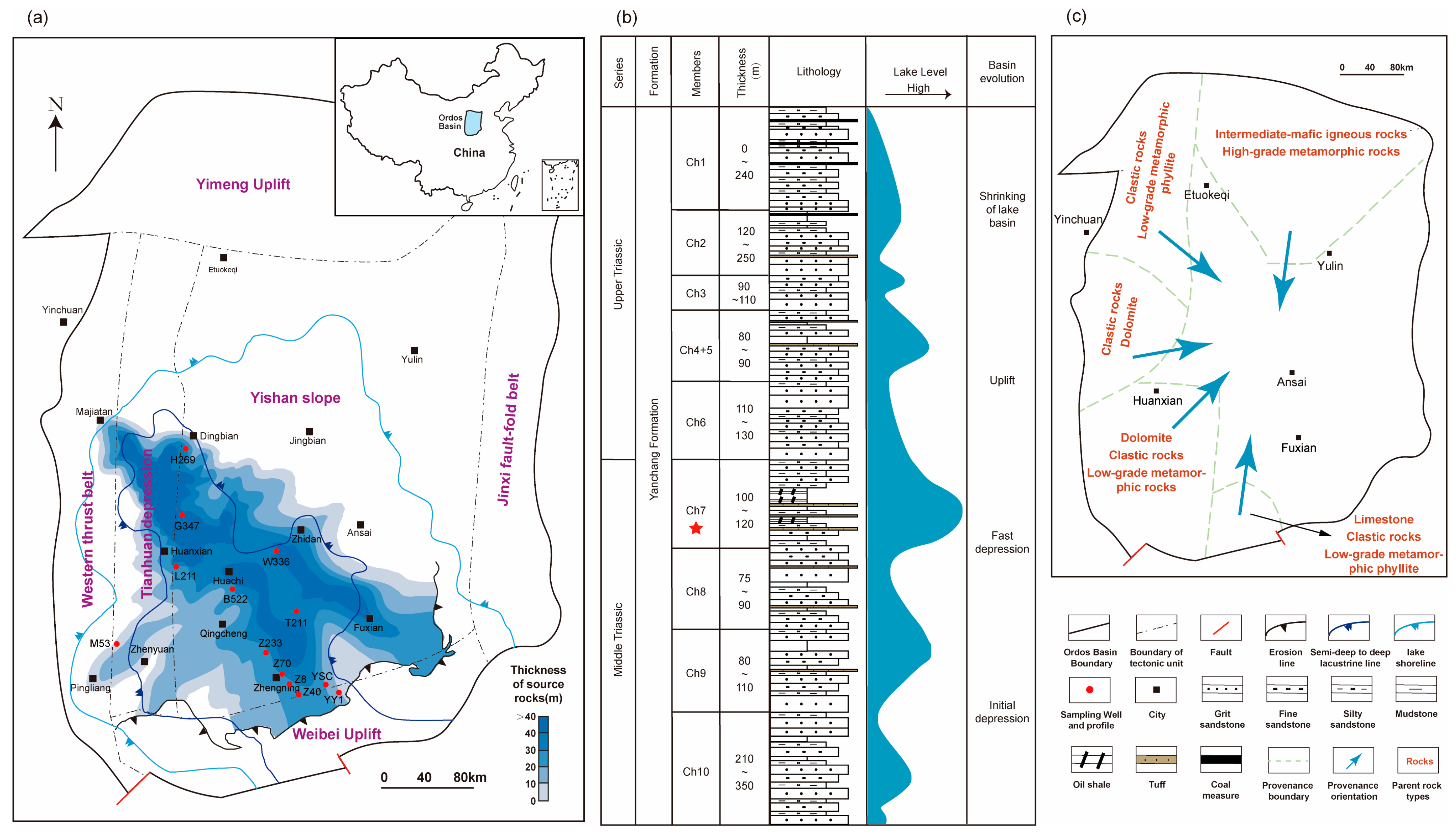
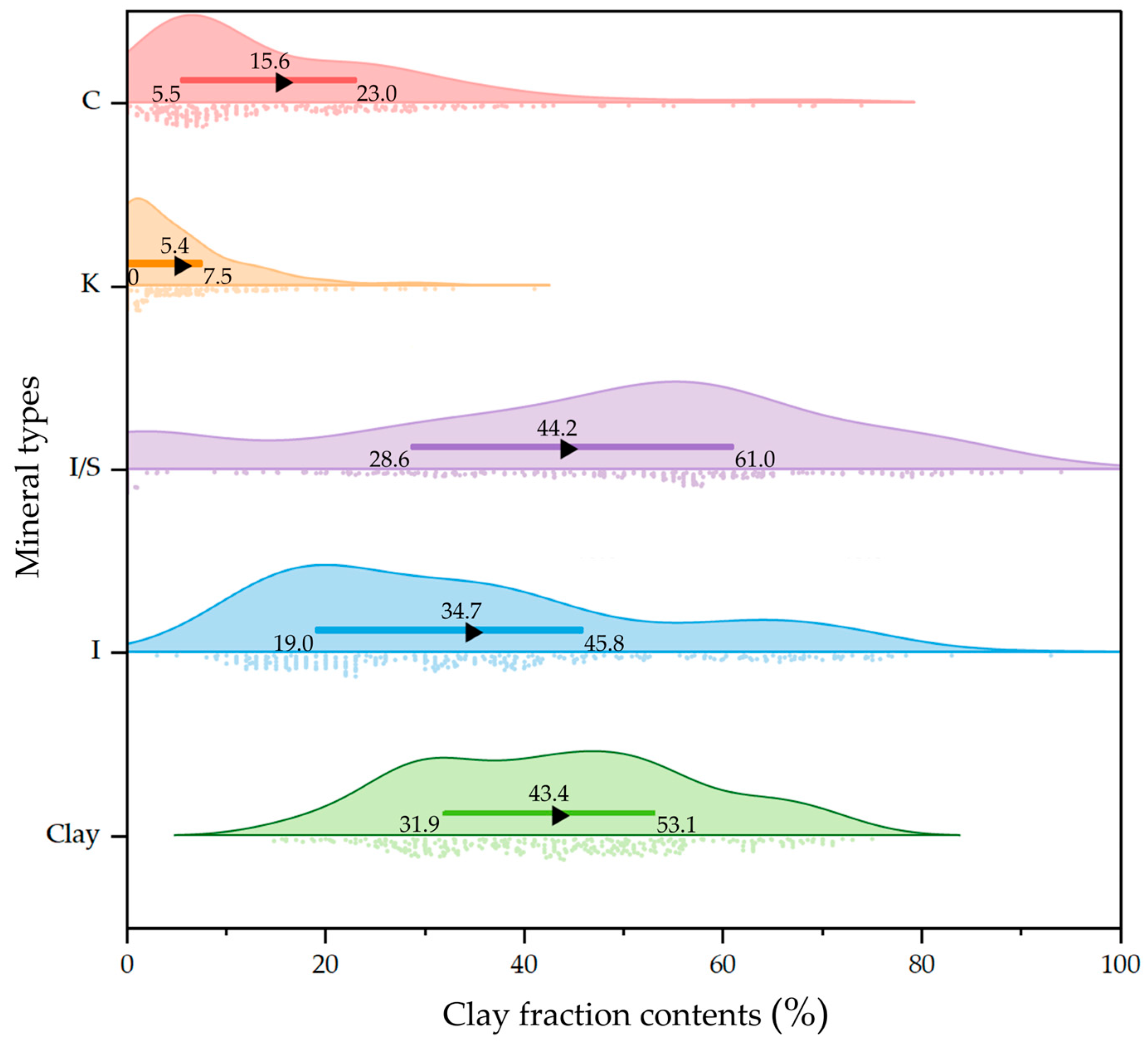
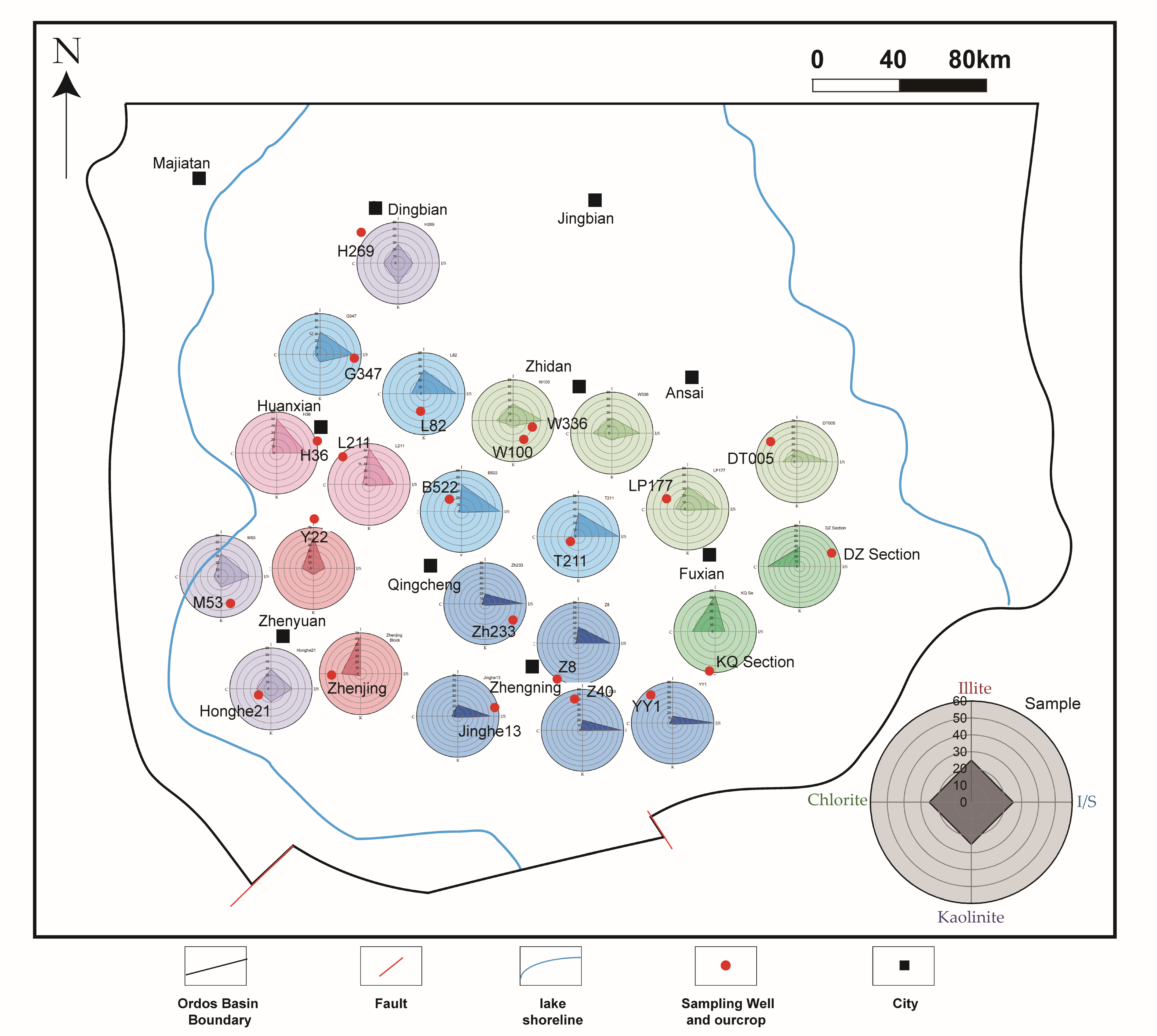
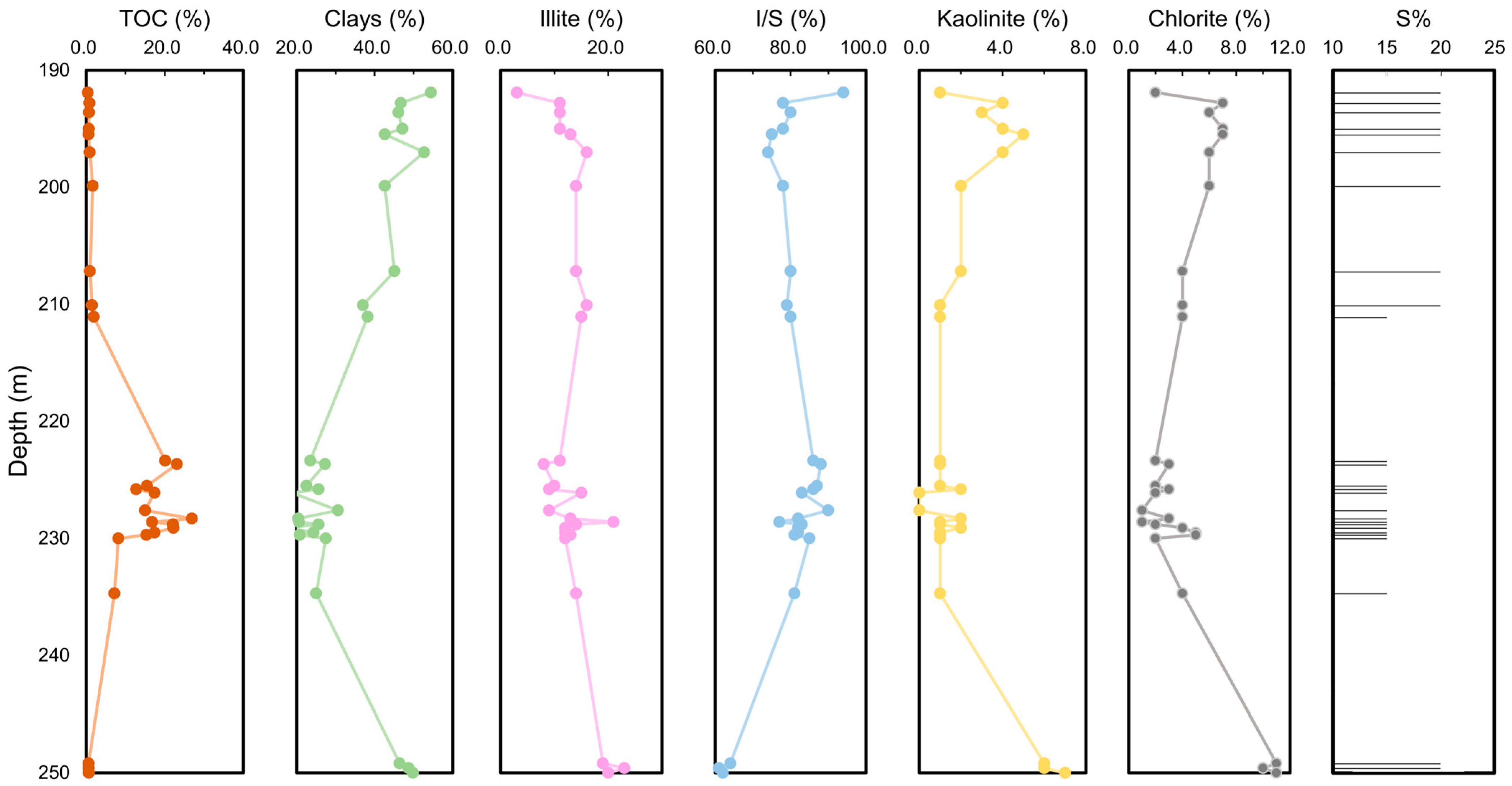
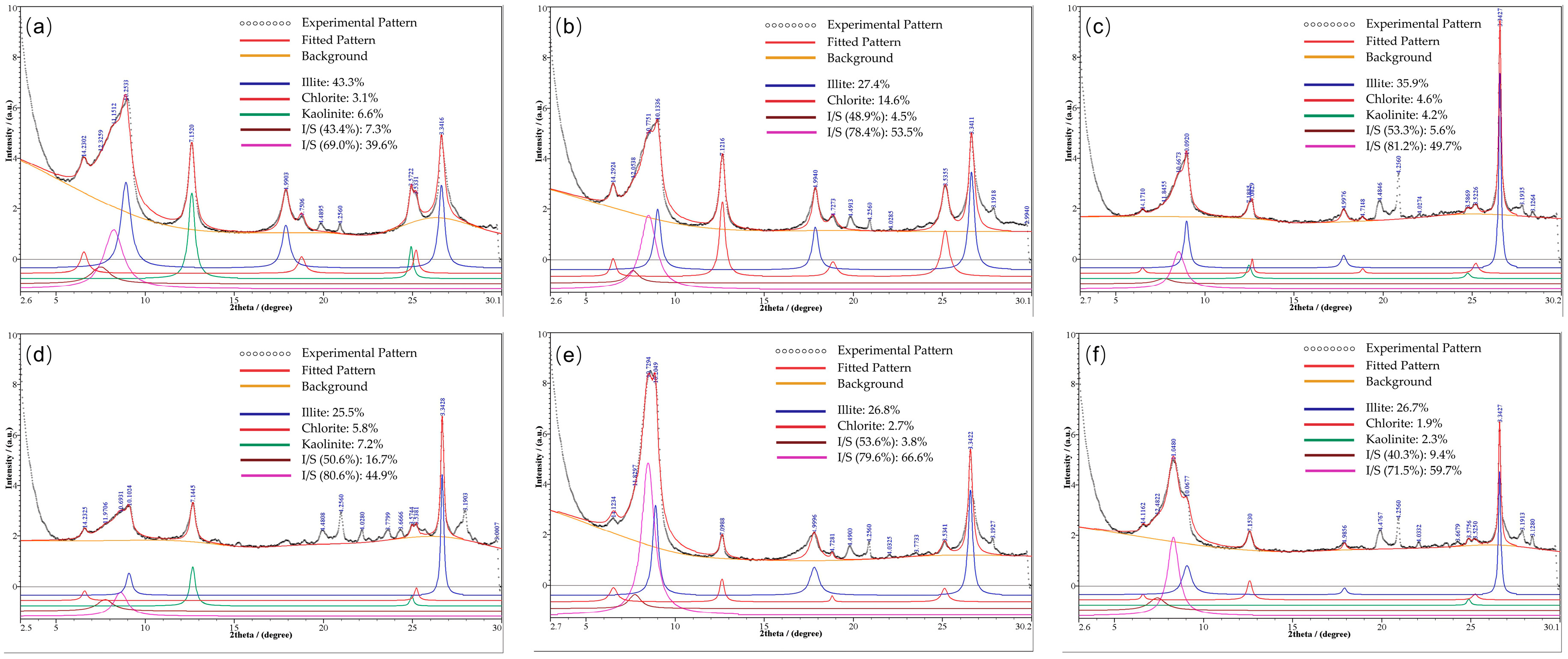

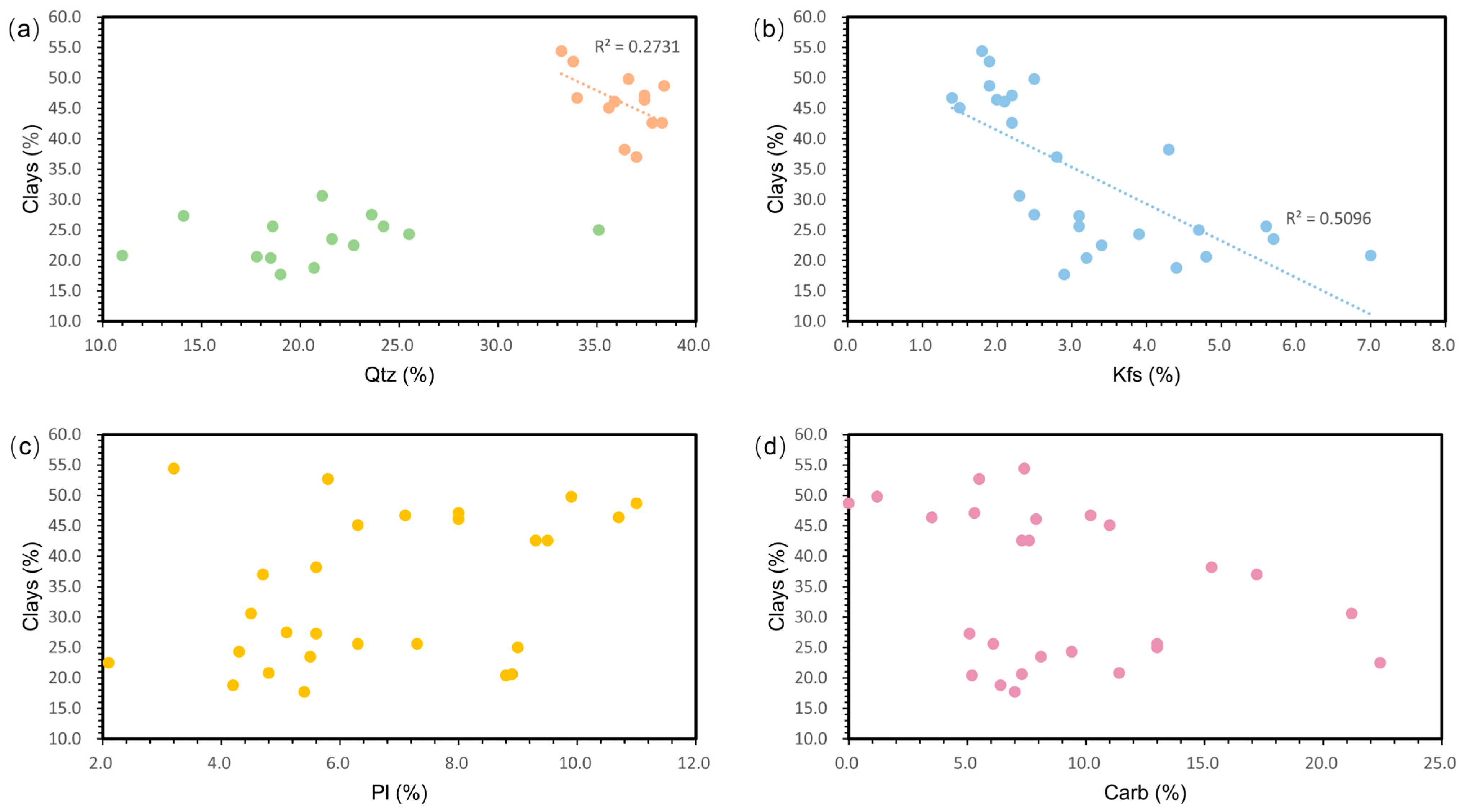
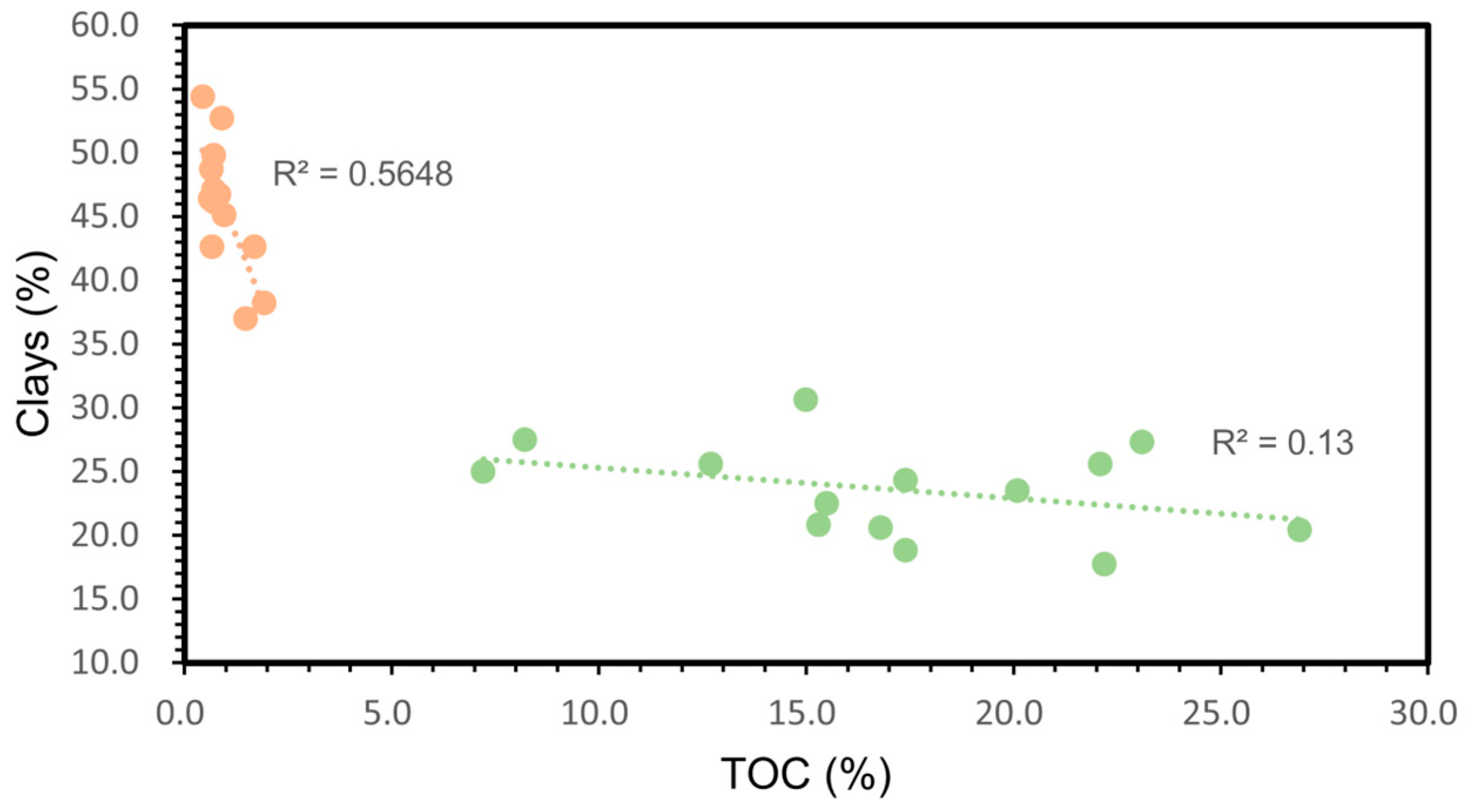
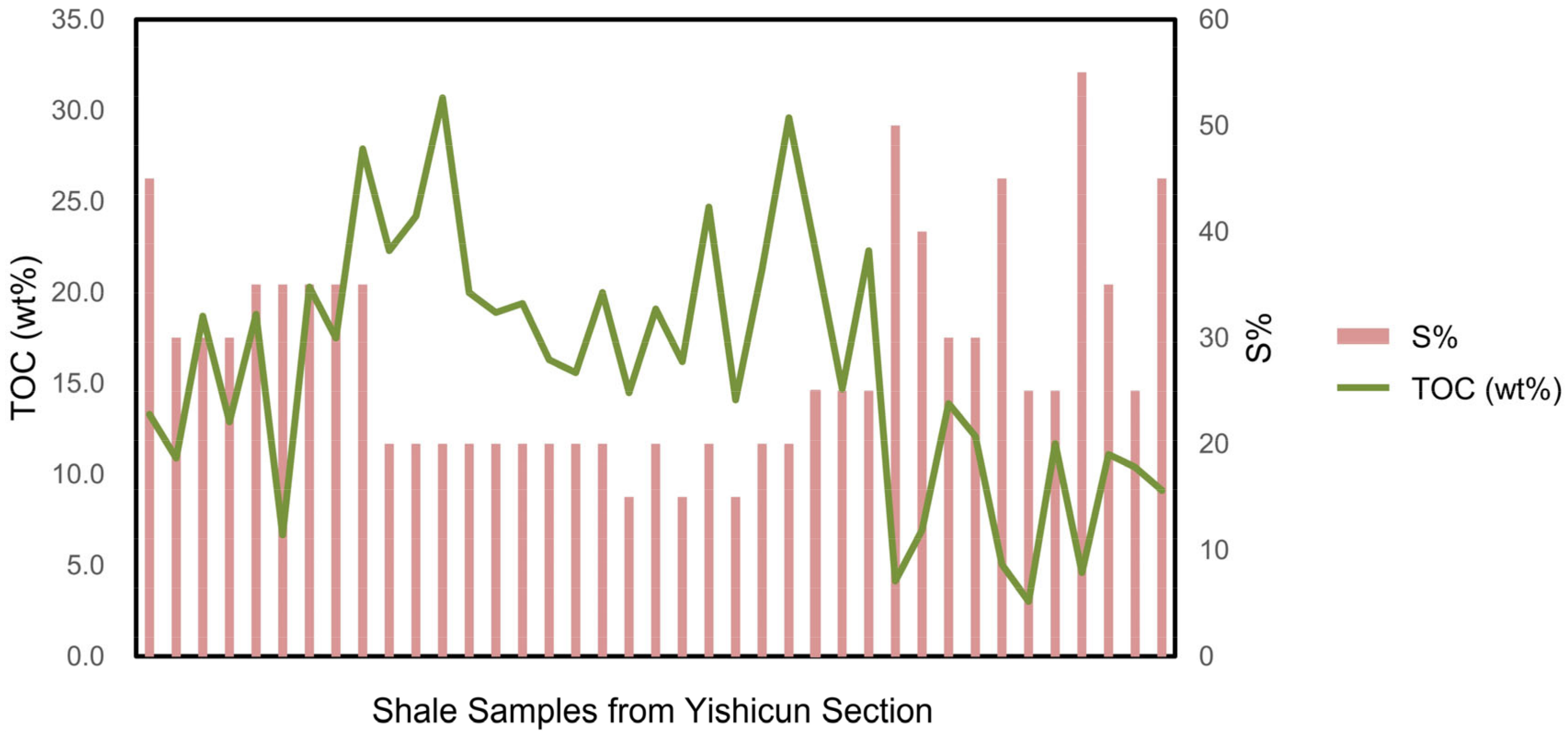
| Well Name | Number of Samples | Clays 1 (%) | I (%) | I/S (%) | K (%) | C (%) | Mixed-Layer Ratio 2 (S%) | Ro% |
| B522 | 3 | 44.1 | 39.7 | 55.9 | 1.4 | 3.0 | 15–20 | 0.88–1.04 |
| G347 | 2 | 50.3 | 33.2 | 48.1 | 11.3 | 7.45 | 25–30 | 0.48 |
| H269 | 3 | 58.4 | 27.2 | 21.4 | 30.4 | 21.0 | 15–20 | 0.77–0.78 |
| H36 | 2 | 58.7 | 49.8 | 43.5 | 0 | 6.7 | 15 | 0.84–0.86 |
| L211 | 3 | 53.0 | 53.1 | 36.0 | 2.1 | 8.8 | 15–20 | 0.72–0.75 |
| L82 | 2 | 39.5 | 35.0 | 47.1 | 0 | 17.9 | 15–20 | 0.81–0.82 |
| M53 | 1 | 48.8 | 33.5 | 41.3 | 15.6 | 9.6 | 20 | 0.55 |
| T211 | 2 | 56.2 | 35.0 | 58.5 | 0 | 6.5 | 15 | NA 3 |
| W336 | 4 | 60.1 | 29.4 | 45.8 | 12.7 | 12.2 | 15–20 | 0.73–0.77 |
| Z233 | 2 | 61.6 | 45.3 | 34.4 | 3.7 | 16.7 | 15 | 0.57–0.58 |
| Z40 | 2 | 58.5 | 20.2 | 76.2 | 0.2 | 3.5 | 20 | 0.55–0.58 |
| Z8 | 3 | 47.5 | 33.3 | 62.3 | 0.3 | 4.1 | 15–20 | 0.57–0.58 |
Disclaimer/Publisher’s Note: The statements, opinions and data contained in all publications are solely those of the individual author(s) and contributor(s) and not of MDPI and/or the editor(s). MDPI and/or the editor(s) disclaim responsibility for any injury to people or property resulting from any ideas, methods, instructions or products referred to in the content. |
© 2025 by the authors. Licensee MDPI, Basel, Switzerland. This article is an open access article distributed under the terms and conditions of the Creative Commons Attribution (CC BY) license (https://creativecommons.org/licenses/by/4.0/).
Share and Cite
Ling, K.; Wang, Z.; Cao, Y.; Liu, Y.; Dong, L. Clay Mineral Characteristics and Smectite-to-Illite Transformation in the Chang-7 Shale, Ordos Basin: Processes and Controlling Factors. Minerals 2025, 15, 951. https://doi.org/10.3390/min15090951
Ling K, Wang Z, Cao Y, Liu Y, Dong L. Clay Mineral Characteristics and Smectite-to-Illite Transformation in the Chang-7 Shale, Ordos Basin: Processes and Controlling Factors. Minerals. 2025; 15(9):951. https://doi.org/10.3390/min15090951
Chicago/Turabian StyleLing, Kun, Ziyi Wang, Yaqi Cao, Yifei Liu, and Lin Dong. 2025. "Clay Mineral Characteristics and Smectite-to-Illite Transformation in the Chang-7 Shale, Ordos Basin: Processes and Controlling Factors" Minerals 15, no. 9: 951. https://doi.org/10.3390/min15090951
APA StyleLing, K., Wang, Z., Cao, Y., Liu, Y., & Dong, L. (2025). Clay Mineral Characteristics and Smectite-to-Illite Transformation in the Chang-7 Shale, Ordos Basin: Processes and Controlling Factors. Minerals, 15(9), 951. https://doi.org/10.3390/min15090951








